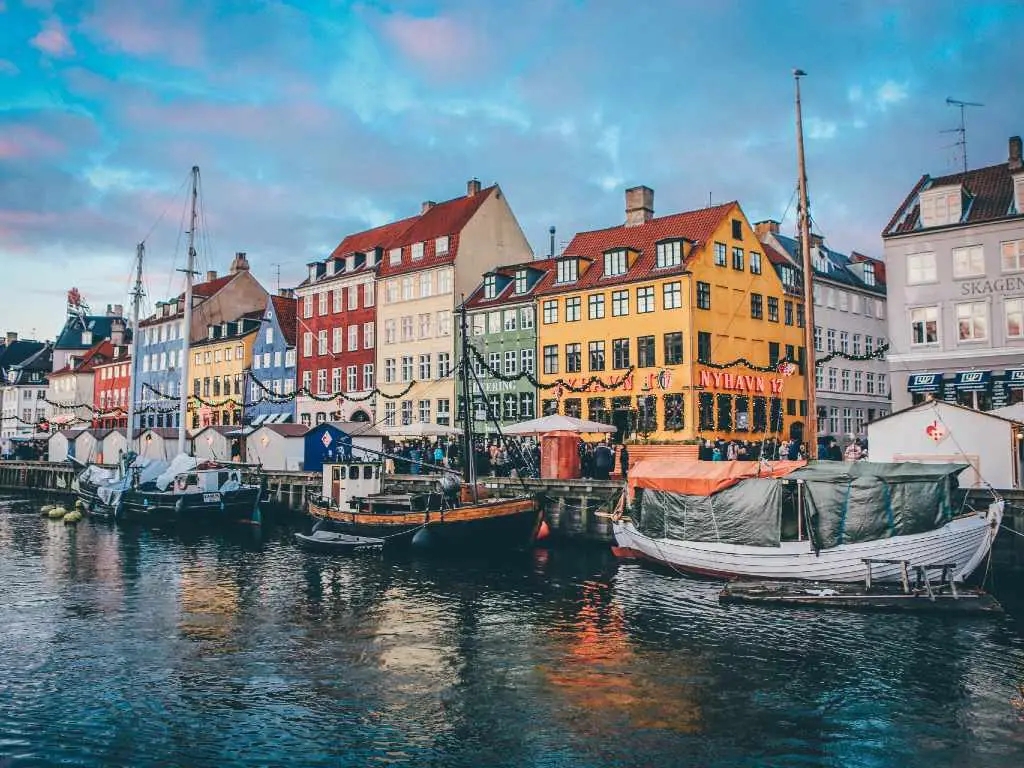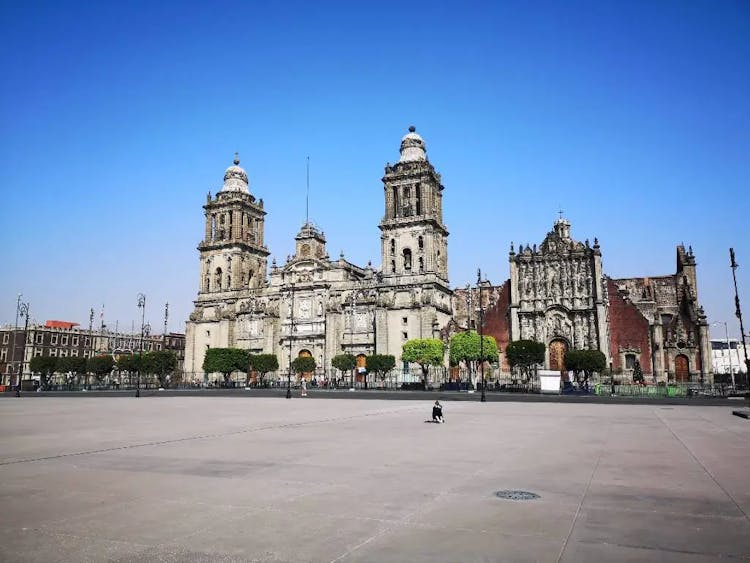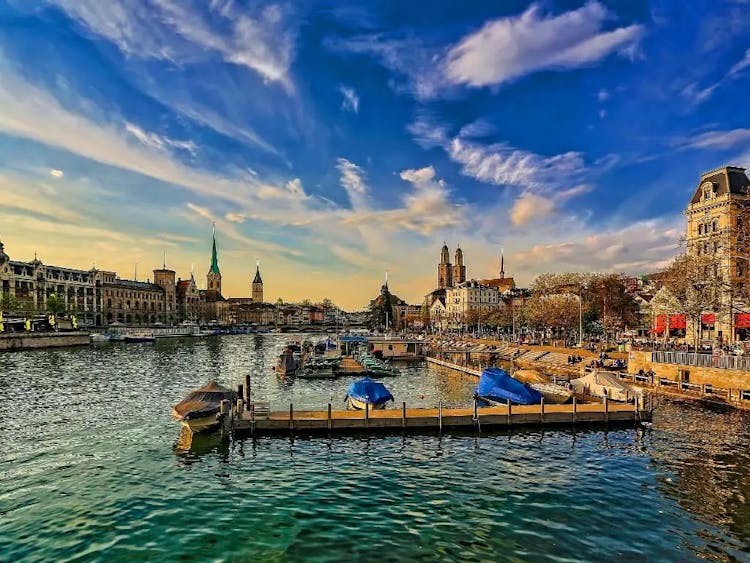
The Layover Guide to Copenhagen
Table of Contents
Denmark’s capital and largest city, Copenhagen epitomizes the culture and relaxed lifestyle that contribute to the country’s frequent position at the top of rankings of the world’s happiest people.
Although you could easily keep yourself busy during an extended stay at the airport, Copenhagen’s compact nature and the proximity of the airport to downtown make it easy to get a sense of the city and see several of the highlights during a layover. Even a few hours in the city is enough to take a canal cruise or rent a bicycle for some exploring, visit a world-class museum or two, check out some historic churches and palaces, or stroll through the lively city center, which includes one of the world’s longest pedestrian shopping streets (make sure you have some extra room in your luggage).
- VISA REQUIRED: No
- MINIMUM CONNECTION TIME: 1 hr
- MINIMUM TIME TO LEAVE THE AIRPORT: 5 hrs
Visa info for Denmark
Denmark is part of the European Union’s Schengen Zone, which allows citizens of many countries, including the United States, to visit for up to 90 days without a visa.
Minimum layover times in Copenhagen
To make a connection: 60 - 90 minutes
Official guidelines for Copenhagen Airport (CPH) recommend a minimum connection time of 40 minutes when connecting to domestic flights and international flights within the Schengen Zone. However, it’s best to allow extra time to ensure you have time to navigate the airport without stress, and to provide a buffer in case of flight delays. Aim for at least 60 to 90 minutes between flights to be on the safe side—add a little more time if you’re coming from outside the Schengen zone (including from the US).
Transferring within CPH is generally a smooth procedure, though depending on your arrival and departure gates, you may have to walk some distance. If you are arriving from outside the European Union, you will have to pass through a security checkpoint. Passengers arriving from or departing to countries outside the Schengen Zone must clear passport control, located by the C gates.
To leave the airport and explore for part of the day: 5 hours
If you want to head into the city for a quick look around, make sure your layover is at least five hours, otherwise you won’t have time to actually do any exploring. You’ll want to make sure you account for transportation back to the airport, clearing airport security, and getting to your gate at least 30 minutes before departure—plus any delays. A 5-hour layover means a little more than 2 hours to explore; a layover of 7-8 hours gives you more time to enjoy the city without rushing.
- 30-45 mins to deplane and go through immigration and customs
- 15 mins to transit to downtown
- 2.5 hours to explore
- 15 mins to return to airport
- 90 mins to go back through security, get to your gate, and board the plane

Getting from the Copenhagen Kastrup airport to the city center
- METRO: 20 mins
- TRAIN: 15 mins
- TAXI: 15 mins
The easiest way to get to downtown Copenhagen from the airport is by metro or train, which takes 15-20 minutes. Taxis take about the same time but will cost a lot more.
Metro trains depart every 5-6 minutes during the day and every 15-20 minutes at night, from a station attached to Terminal 3. Central Copenhagen stops include Christianshavn, Kongens Nytorv, and Nørreport. Intercity trains, operated by DSB, run from a station beneath Terminal 3 to Copenhagen Central Station. Unlike the metro, which terminates at the airport, the DSB train continues across the Øresund strait to Sweden, so make sure you get on the train in the right direction.
Tickets for both the metro and the train cost DKK 36 (about $5.50) and are valid for 90 minutes. They can be purchased from ticket windows or ticket machines in Terminal 3.
How to spend a short layover at the Copenhagen airport
With more than 120 shops and restaurants, CPH sometimes feels more like a mall than an airport. Nordic brands abound, including H&M, Lego, Georg Jensen, Marimekko, and others. There are also outlets of the Danish department store Illums Bolighus and the usual array of high-end fashions and accessories from international brands such as Gucci, Hermès, Marc Jacobs, and Burberry. There are many restaurants, bars, and cafes serving everything from classic Danish open-faced sandwiches, pub grub, and French bistro fare to sushi, tapas, and Vietnamese street food, along with a wide selection of beer, wine, and cocktails. There’s free WiFi throughout the airport, and various lounges that are accessible to any traveler for a fee.
To get rid of the aches and pains of travel, pay a visit to the Physiotherapy CPH clinic in Terminal 2 (outside security), where services include therapeutic massage, acupuncture, and other treatments. For a cheaper option, there are massage chairs throughout the airport.
Just outside the airport, adjacent to Terminal 3, the Ni’mat Spa at Clarion Hotel Copenhagen Airport has a steam room, a heated saltwater pool, and treatment rooms. Admission is DKK 250 (DKK 125 for overnight hotel guests) but is included if you book a treatment.

How to spend a short Copenhagen layover outside the airport
If you’ve got several hours to kill, hop on the metro from Terminal 3 for the 15-minute ride to Kongens Nytorv in the city center. From here it’s a short walk to the picturesque small harbor Nyhavn, which is lined with colorful 17th- and 18th-century houses, many of them with cafes and restaurants at ground level. Nyhavn is one of the starting points for 60-minute sightseeing cruises on Copenhagen’s canals, among the best ways to experience the city. Nettobådene and Stromma both have frequent departures year-round.
Denmark’s monarchy is one of the world’s oldest, so it’s hardly surprising that the country is brimming with palaces. Situated roughly in a triangle around the city center are three that are well worth visiting: Amalienborg, Rosenborg, and Christiansborg. If you only have a few hours in Copenhagen, you’ll probably have to pick just one, but if you’re staying overnight, you could conceivably hit all three.
A couple of blocks from Nyhavn, Amalienborg Palace is the winter home of the Danish royal family. It’s actually a complex of four palaces with identical facades, arranged around an octagonal courtyard where the changing of the palace guard takes place daily at noon. Two of the palaces are open to the public. While you’re in the area, stop into the splendid Marble Church (officially named Frederiks Kirke), which faces Amalienborg and is known for its towering dome, the largest in Scandinavia. This Baroque masterpiece was begun in the mid-18th century, but stood unfinished for more than a hundred years before being completed in 1894.
West of Amalienborg is Kongens Have (the King’s Garden), a popular urban oasis with expansive lawns, rose gardens, and the turreted red-stone Rosenborg, a 17th-century Dutch Renaissance castle with interiors spanning 400 years of royal history. It also houses the royal treasury, where you can gape at the Danish Crown Jewels and other regalia. At the south end of downtown, on the small island of Slotsholmen, Christiansborg Palace houses the Danish Parliament, the Supreme Court, and the Ministry of State. The Queen receives foreign ambassadors and visiting heads of state in the opulent Royal Reception Rooms, which are open to tourists when not in use, along with the stables, the kitchen, the 19th-century chapel, and the ruins of earlier medieval castles beneath the present palace. The 348-foot Christiansborg Palace Tower is the highest in Copenhagen and provides panoramic views, free of charge.
How to spend an overnight layover in Copenhagen
If you’re in town overnight or have a long layover in Copenhagen, there’s plenty more to keep you occupied. From Kongens Nytorv, a walk along Strøget, Europe’s longest pedestrian shopping street, will eventually take you to Rådhuspladsen, dominated by the red-brick City Hall. Across the street lies the famous Tivoli, a mix of gardens, amusement park attractions, restaurants, shops, and entertainment venues. The park celebrated its 175th birthday in 2018 and is open late into the evening. Though a bit pricey, it’s a quintessential Copenhagen experience that’s particularly magical as darkness falls and thousands of fairy lights illuminate the buildings and gardens. Nearby, the National Museum of Denmark has exhibits covering Danish history from prehistory to modern times, as well as classical and Near Eastern antiquities and ethnographic collections from around the world.
In addition to the Christiansborg tower, there are two other towers that offer great views of different parts of Copenhagen. North of Strøget, near the Nørreport metro station, the 17th-century observatory called Rundetårn (the Round Tower) has a spiral ramp instead of stairs and an outdoor viewing platform encircling the top of the tower. On the other side of the harbor, in the pretty Christianshavn neighborhood, Vår Frelsers Kirke (the Church of Our Saviour) boasts another of Copenhagen’s best viewpoints: a distinctive spire with an external staircase to the top. It’s well worth the climb but definitely not for the fainthearted.
For a short stay in Copenhagen, your best bet is to book a hotel in the city center to maximize your time for exploration. Indre By (the Inner City) encompasses many of Copenhagen’s top attractions and has easy access to the airport via public transportation. Southwest of the city center, beyond the railway station, the former red-light district of Vesterbro is a bit more affordable but still within walking distance of many sights.
If you’re arriving into CPH late and have a morning or midday flight out the following day, you’re probably better off spending the night at a hotel near the airport instead of traveling into the city. Copenhagen bars and nightlife generally shut down around midnight except on weekends, when many stay open until the wee hours of the morning. That said, if you’re visiting between May and July, the sun won’t set until after 9pm (nearly 10pm around the summer solstice), giving you time for a sunset walk along the canals even if you arrive in the evening.

Need to Know
- CURRENCY: Danish Krone
- LANGUAGE: Danish
- SAFETY: A+
- COST: $$$$ (out of $$$$$)
- BEST TIME TO GO: May–Sept
Currency in Denmark
The official currency is the Danish krone, abbreviated DKK (plural: kroner). There are both ATMs and currency exchange outlets in the airport terminal. Prices for tourist services and attractions are sometimes listed in euros as well as kroner, though euros are not widely accepted beyond certain tourism establishments.
Cost in Copenhagen
There’s no denying it: Denmark is expensive. A mid-range hotel in the city averages around $150 a night, though prices can vary quite widely. A mid-range dinner will likely cost from $30 to $50 and up per person, depending on the location and the number of courses. High taxes also bump up the cost of alcohol, though not as much as in neighboring Sweden and Norway, where sales are controlled by state monopolies.
If you plan to do a lot of sightseeing during a short period of time, consider buying a Copenhagen Card, which provides free admission to 87 top attractions, including palaces, museums, churches, canal tours, and Tivoli. Prices start at DKK 399 ($64) for adults and DKK 199 ($32) for children for a 24-hour pass.
Weather & Best Time to Go to Copenhagen
May through September generally offer the best combination of daylight and pleasant weather. October has more variable weather but is a good time for autumn foliage and special fall events. In early November the Christmas season begins, with holiday markets galore and plenty of gløgg (hot mulled wine) to warm you up as the days turn colder. Late winter is a time when Danes hunker down and embrace the concept of hygge (coziness). Days are short and the weather is cold and often windy, but palaces and museums are still open for visitors, and even canal boat tours are still operating (with glass tops). Mid-April through May is the perfect time to visit if you want to see flowers throughout the city’s parks and gardens burst into brilliant bloom.
Average temperatures in July and August range from lows in the mid-50s to highs of around 70 degrees Fahrenheit. Summer heat waves do occur, however, so it’s worth noting that many Copenhagen hotels and attractions do not have air conditioning. The coldest months of the year are typically January and February, with lows in the upper 20s and highs around 35 degrees Fahrenheit. Spring temperatures top out at around 50 degrees in April and near 60 in May, with lows in the mid-30s to mid-40s. In fall, temps drop from about the 50s or low 60s in September to the upper 30s to mid-40s in November.
Safety in Copenhagen
Denmark is one of the safest countries in the world, but as in most large cities, it’s important to beware of pickpockets, especially in crowded areas, at popular tourist spots, and when getting on and off public transportation. There have been instances of gang violence in Christiania and Nørrebro, so take extra caution if visiting these areas, especially at night. Cannabis is widely sold in the independent enclave of Freetown Christiania, and police raids are common. The colorful neighborhood is worth wandering through, but refrain from taking photographs of without permission, especially of people.
An additional note of caution for pedestrians: beware of bicycles. Biking is one of the primary modes of transportation in Copenhagen—in fact, it’s said there are more bicycles than people in the city—and dedicated bike lanes are everywhere. Be extra careful when crossing these lanes or stepping out into any street, as bicyclists will not stop (and will be quite unhappy if you get in their way).
Transport in Copenhagen
Central Copenhagen is fairly compact, making it easy to explore on foot or on two wheels like most Danes do. Copenhagen Bicycles at Nyhavn has rental bikes and also guided tours by bicycle. Another option is to create an account with Bycykeln, which has stations throughout the city where you can check out electric bicycles using an app; usage is billed in increments of 20 minutes.
In addition to the metro, Copenhagen’s efficient public transportation network includes buses, commuter trains, and harbor buses. Single tickets are priced according to zones of travel, with each zone costing DKK 12. For trips within the city center, two zones is all you’ll need; to the airport, it’s three. Fare are valid for 75 minutes for two zones, with an additional 15 minutes per additional zone. Up to two children ride free with a paying adult. Tickets may be used on all forms of transportation run by DOT, with unlimited changes during the period of validity.
Food & Drink in Copenhagen
With an impressive 16 Michelin-star restaurants, Copenhagen has become synonymous with creative New Nordic cuisine, a fusion of traditional Scandinavian ingredients with international influences. Fortunately you don’t have to score a sought-after booking at one of these top restaurants or spend a fortune to sample Copenhagen’s dynamic culinary scene. A great place to enjoy a variety of delicious food is Torvehallerne, a pair of glass-enclosed food halls a block from the Nørreport metro station. The many small eateries serve everything from fresh-baked breads and gourmet porridge to pasta, salads, tapas, and sushi. There are also plenty of market stalls where you can pick up a wide range of items for a picnic in one of the nearby parks.
A staple of the Danish diet that you’re sure to come across is rugbrød, a dense rye sourdough bread served with butter or as the base for smørrebrød, a traditional open-faced sandwich laden with cheese, cold cuts, smoked fish, paté, or other toppings. It’s easy to find in cafes and restaurants throughout the city, but don’t expect it to be cheap.
Denmark is also known for its sweet treats, including kanelsnegle (cinnamon rolls), æbleskiver (round, puffy pancake balls), and hindbærsnitter (raspberry shortbread bars similar to Alexandertorte). Don’t go trying to order a Danish, though--the pastry known by that name in the United States is called wienerbrød (Vienna bread) in Denmark.
Language
Danish is the official language, but almost everyone speaks English, and many services and attractions are signed in both languages.
Don’t Miss
Art lovers won’t want to miss Ny Carlsberg Glyptotek, a museum founded by Carl Jacobsen of the Carlsberg beer brewing family. Housed in a series of four interconnected mansions set around a lush, plant-filled courtyard topped by a large cupola, its stunning collections focus on art and archaeology from the ancient Mediterranean, as well as 19th-century Danish and French paintings. The museum cafe is a peaceful oasis in the atrium. There’s also a rooftop terrace with good views of Tivoli and the surrounding area. Admission to the Glyptotek is free on Tuesdays.
Don’t Bother
One of Copenhagen’s most famous attractions is the Little Mermaid statue depicting the main character from the beloved story by H.C. Andersen; however, the statue itself is quite small and somewhat underwhelming, especially since she’s often mobbed by visitors queuing for photos. Canal boat tours include the Little Mermaid, but since she faces the shore, you’ll only see her back. If you want to see her face, it’s a pleasant walk of just over a mile along the harborfront from Nyhavn.
Read our tips for booking a flight with a long layover or get more ideas for where to go in Europe.
See Going's deals on flights to Copenhagen, and join today to get cheap flights from all over the world delivered right to your inbox.
Published November 30, 2023
Last updated December 21, 2023
Treat your travel to cheap flights
Most deals are 40-90% off normal prices with great itineraries from the best airlines. If it's not an amazing deal, we won't send it. Sign up for free to start getting flight alerts.




